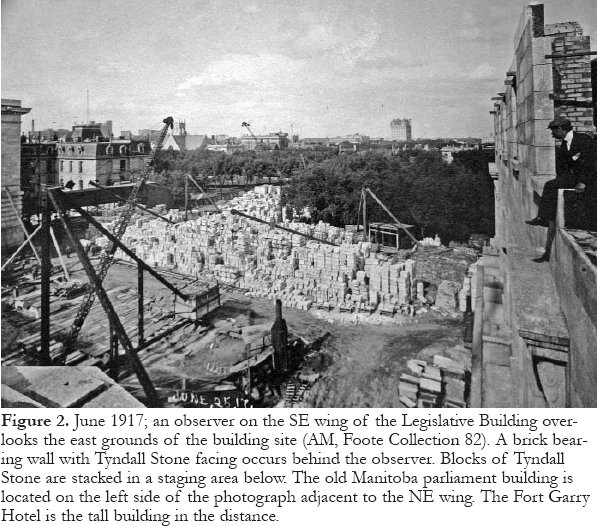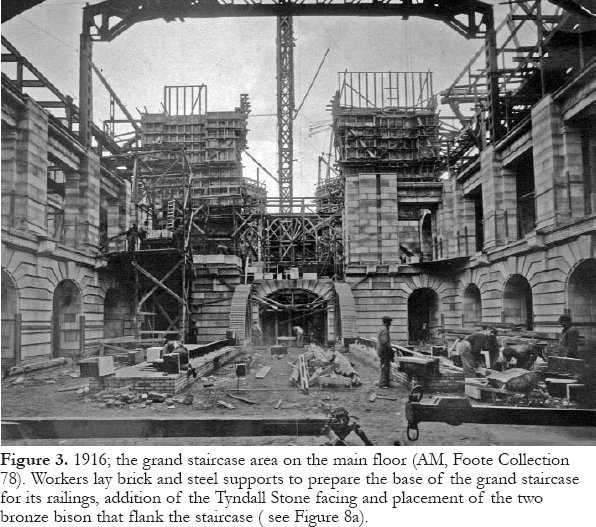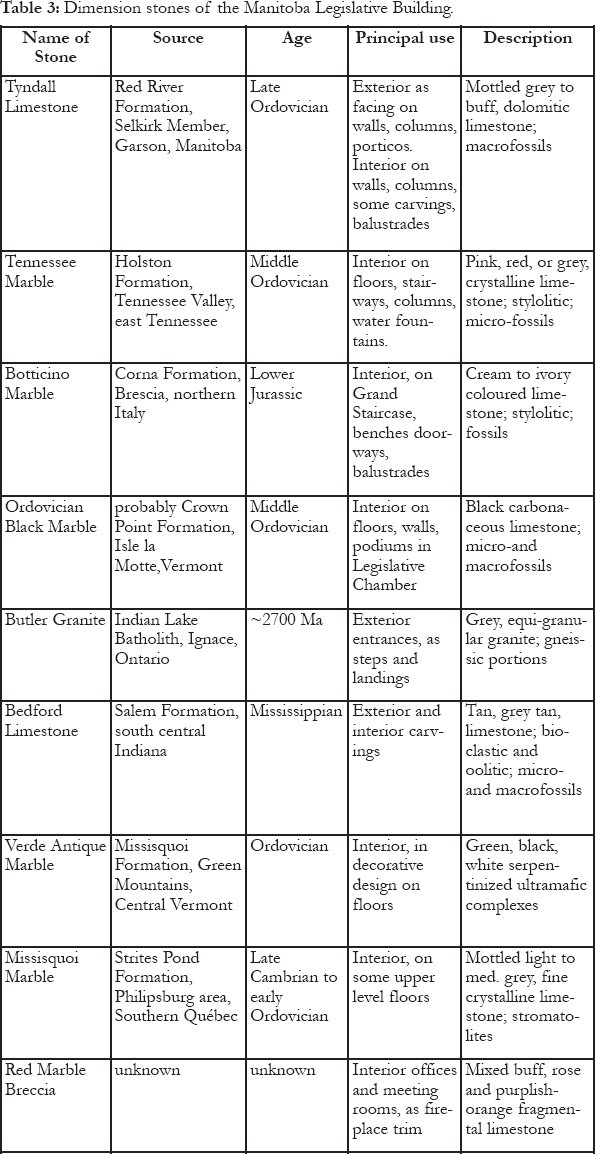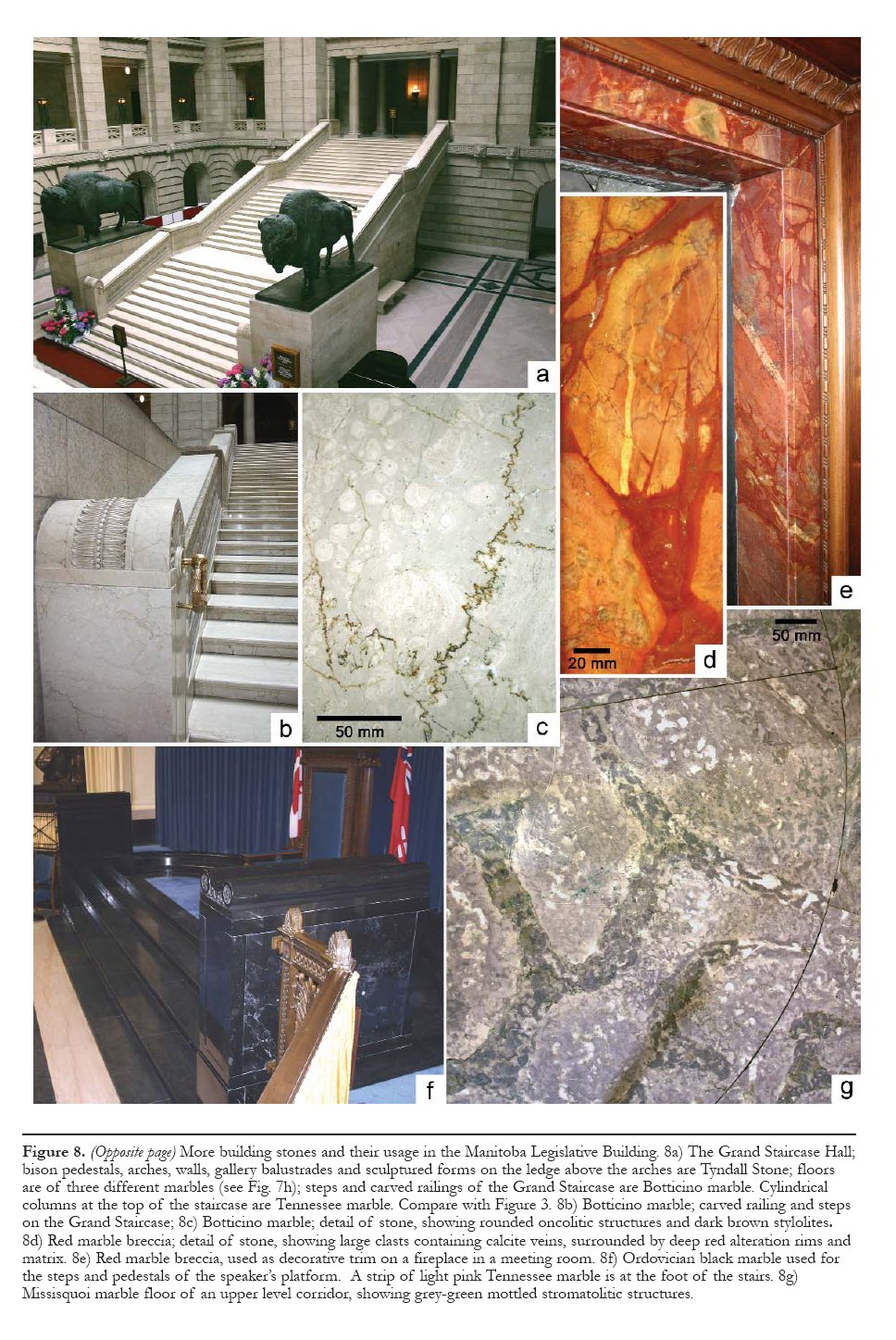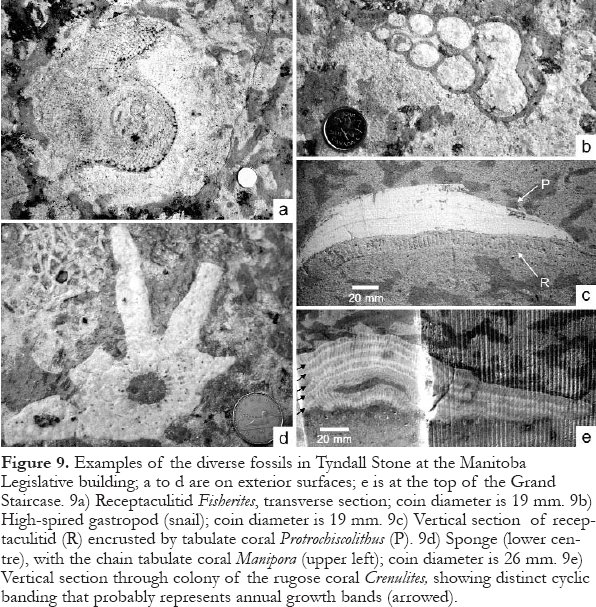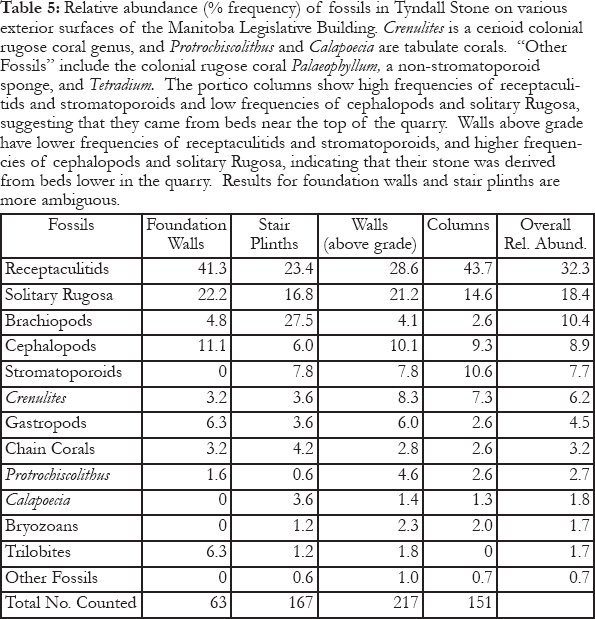Geology of the Parliament Buildings 5: Geology of the Manitoba Legislative Building
W. C. BrisbinDepartment of Geological Sciences, University of Manitoba, Winnipeg, MB R3T 2N2
Graham Young
The Manitoba Museum, 190 Rupert Ave., Winnipeg, MB R3B 0N2
Jeff Young
Department of Geological Sciences, University of Manitoba, Winnipeg, MB R3T 2N2
jyoung@cc.umanitoba.ca
SUMMARY
The Manitoba Legislative Building was designed by Frank Worthington Simon, assisted by Henry Boddington III, architects from Liverpool, England. The building style is neoclassical, incorporating Greek, Roman and Egyptian motifs and elements. Construction was completed early in 1920 and the building was dedicated July 15, 1920, on the fiftieth anniversary of the Province. The building is located in central Winnipeg, close to the north bank of the Assiniboine River and rests on 14 m of glacial Lake Agassiz clays over till and limestone bedrock. The mass of the building is supported by 421 concrete caissons that extend through the clays to indurated till or bedrock. Steel frames rest on the caissons and support bearing walls constructed of bricks manufactured from Manitoba shale and clay. Dimension stones decorate the bearing walls inside and outside, and the floors and stairways within. Each type of stone has its own decorative characteristics and each records geologic processes at different times in Earth history. The predominant dimension stone both outside and inside the building is Manitoba Tyndall Stone. Grey, pink and red Tennessee marbles are from the southern Appalachians. Botticino marble was quarried in the foothills of the Alps in northern Italy. Ordovician black marble and Verde Antique are from the Vermont-New York region in the northern Appalachians. Missisquoi marble is from quarries in southern Québec near Philipsburg, and also represents a northern Appalachian source. Bedford limestone, used for most of the statuary, is from south-central Indiana. Butler granite from Ignace, Ontario, was used for steps and floor surfaces of all four porticos. Red marble breccia, used to decorate most fireplaces, may have come from northern France.SUMMAIRE
L'édifice du Palais législatif du Manitoba a été conçu par Frank Worthington Simon, assisté de Henry Boddington III, deux architectes de Liverpool en Angleterre. Il s'agit d'un édifice de style néoclassique comprenant des éléments et des motifs grecs, romains et égyptiens. Sa construction s'est achevé au début des années 1920 et son inauguration a eu lieu à l'occasion du cinquantième anniversaire de la Province, soit le 15 juillet 1920. L'édifice est situé au cœur de Winnipeg, non loin de la rive nord de la rivière Assiniboine, la géologie environnante consistant en une couche d'argile du lac Agassiz de 14 m d'épaisseur reposant sur du till et un socle calcaire. Le poids de l'édifice repose sur 421 caissons de béton qui s'enfoncent jusqu'au till consolidé ou jusqu'au socle. Des structures d'acier appuyées sur ces caissons supportent le poids des murs de briques fabriquées avec des schistes argileux et des argiles du Manitoba. Des pierres de taille parent les murs porteurs à l'extérieur comme à l'intérieur ainsi que les planchers et les escaliers intérieurs. Chaque type de pierre de taille présente des caractéristiques particulières, et chacun témoigne de processus géologique d'une époque particulière de l'histoire de la Terre. La pierre de Tyndall est celle qui prédomine tant à l'extérieur qu'à l'intérieur. Les marbres gris, roses et rouges du Tennessee proviennent du Sud de la chaîne des Appalaches. Les marbres de Botticino ont été extraits du piémont des Alpes dans le Nord de l'Italie. Les marbres noirs et les porphyres verts antiques proviennent des États du Vermont et de New York, au Nord des Appalaches. Les marbres de Missisquoi ont été extraits de carrières du Sud du Québec près de Phillipsburg proviennent aussi du Nord des Appalaches. Les calcaires de Bedford qui ont été principalement utilisés comme matériau statuaire proviennent du centre-sud de l'État d'Indiana. Les granites de Butler provenant de Ignace en Ontario ont été utilisés pour les marches et les planchers des quatre portiques. La brèche de marbre rouge qui a été utilisée pour la décoration de la plupart des foyers pourrait provenir du Nord de la France.
INTRODUCTION
1 The geology of the Manitoba Legislative Building encompasses the subsurface geological conditions of its site, and the source and characteristics of the dimension stones and of other geological materials used in its construction.
2 The first Legislative Building was opened in 1871. This humble, rough-hewn log building was destroyed by fire on December 3, 1873. A second, architecturally-designed Legislative Building was completed in 1884. It served the legislative requirements of Manitoba for a short time only. Rapid growth of the province in the early 1900s led to the need for a much larger building. Consequently, in 1911, plans for the third, and current, Legislative Building were set in motion.
3 A history of the design competition, site selection, planning, financing, political controversy, and construction of Manitoba's third Legislative Building is in the remarkable book Symbol in Stone (Baker, 1986). The following are some highlights.
4 A competition for the design of the building was won by the team of Frank Worthington Simon, assisted by Henry Boddington III, architects from Liverpool, England. The site selected in Winnipeg is near the Assiniboine River, immediately east of the Osborne Street Bridge (Fig. 1). The building is neoclassical, incorporating Greek, Roman and Egyptian motifs and elements. Bodnar (1979, p.136) described it as "exhibiting a graceful simplified quality, Beaux-Arts in its arrangement of masses and spaces, but more complex in its treatment of plan and dome." The plan of the building is in the form of an H. The mass of the building is supported by concrete caissons that extend to indurated till or bedrock. Structural brick piers faced with dimension stone comprise the exterior walls, and structural brick piers faced with dimension stone or plaster, are used for the interior walls. Floors are concrete, covered by dimension stone or terrazzo.
Figure 1. Plan of the Manitoba Legislative Building and the surrounding area. Modified from Leslie (1925).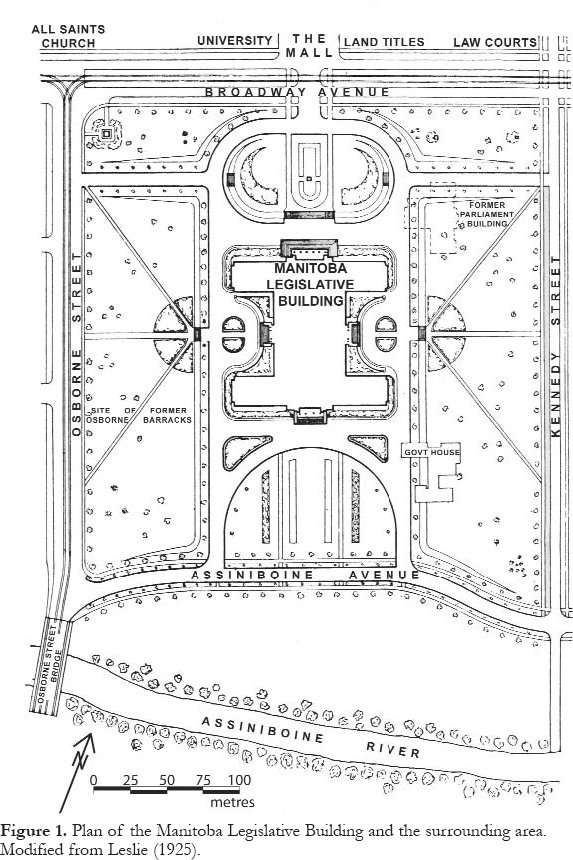
Display large image of Figure 1
5 Construction began in 1913. The general contract for construction was awarded to Thomas Kelly and Sons in July 1913. In January 1915, after a delay caused by the start of World War I, a review revealed financial and contractual improprieties, and the Kelly contract was terminated. Furthermore, problems with defective caissons delayed construction. It was not until the end of 1916 that new tenders were called to complete the construction. The new general contractor was J. McDiarmid and Company. Figures 2 and 3 show the different stages of construction.
6 By February 1920, the new Legislative Building was completed. It was dedicated July 15, 1920, on the fiftieth Anniversary of the province. Figure 4 is a current view of the front of the building.
7 At completion, a list of costs was issued by the Manitoba Department of Public Works (Table 1, Anonymous, 1921). Baker (1986), with the benefit of an historical review, estimated the cost as $9,379,000, not including interest on the debt after the dedication and opening.
SITE FOUNDATION CONDITIONS
Excavation of the Foundation
8 On July 21, 1913, two steam shovels began excavating the sub-basement at the site of the new Legislative Building. Excavation took 31 days, although seven days were lost because of rain and equipment breakdowns. After five days of excavation, the design plans were modified by, 1) moving the site of the Legislative Building 13 m southward toward the Assiniboine River and away from the main access artery, Broadway Avenue, and 2) raising the terrace adjacent to the building by 0.6 m, and the building by 0.3 m, thus reducing the depth of excavation from 2.5 m to 1.5 m (Manitoba Royal Commission, 1915). Raising the building added an additional 0.3 m of cut stone along the perimeter of the building. During excavation about 16,000 m3 of soil were removed. Some of the excavated soil was probably used to add a raised terrace adjacent to the Legislative Building.
Figure 2. June 1917; an observer on the SE wing of the Legislative Building overlooks the east grounds of the building site (AM, Foote Collection 82). A brick bearing wall with Tyndall Stone facing occurs behind the observer. Blocks of Tyndall Stone are stacked in a staging area below. The old Manitoba parliament building is located on the left side of the photograph adjacent to the NE wing. The Fort Garry Hotel is the tall building in the distance.Figure 3. 1916; the grand staircase area on the main floor (AM, Foote Collection78). Workers lay brick and steel supports to prepare the base of the grand staircase for its railings, addition of the Tyndall Stone facing and placement of the two bronze bison that flank the staircase ( see Figure 8a).Foundation Conditions
9 The stratigraphy underlying the Legislative Building was documented in logs from eight test holes sunk in 1912 and 1913 (AM, GR 3085 G8106, Item 176), logs acquired during caisson excavation (AM, GR 3085 G8100, Item 6, AM, GR 3085 G8107, Item 549) and logs acquired during later examination of selected caissons (AM, GR 3085 G8105, Item 121, AM, GR 3085 G8105, Item 122, AM, GR 3085 G8106, Item 196, AM, GR 1609 G8014, File 3 Item 2). This later examination was in response to cracks that developed in the floors and walls of the Legislative Building during construction, particularly along the north outside wall under both wings and the north portico. These logs revealed a stratigraphy consisting of bedrock, commonly overlain by indurated till and unconsolidated boulder clay, overlain by grey and yellow clay and capped by a thin black loam.
10 The bedrock underlying the Legislative Building consists of carbonate rocks of the lower part of the Fort Garry Member of the Red River Formation (Baracos and Kingerski, 1998). The depth to bedrock is 14 to 15 m from the top of the horizontal steel frame resting on the caissons (i.e., grillage), except under the north part of the building where it occurs at 14 to 20 m (Fig. 5). Bedrock relief in the northeast wing and under the north portico defines abrupt depressions that drop up to several metres (AM, GR 3085 G8106, Item 196, AM, GR 1609 G8014, File 3 Item 2). These depressions in the bedrock surface are consistent with paleokarst features underlying Winnipeg (Baracos and Kingerski, 1998).
Figure 4. The Manitoba Legislative Building viewed from the north in spring 2005. Visitors are greeted at the front entrance by six ionic columns capped with a pediment symbolizing Canada. A sculpture of Queen Victoria, seen on the front lawn of the building, is one of many sculptures on the grounds. The refurbished Golden Boy atop the building symbolizes Manitoba's eternal youth and progress. Government House, the residence of the Lieutenant-Governor of Manitoba, is located on the left side of the photograph.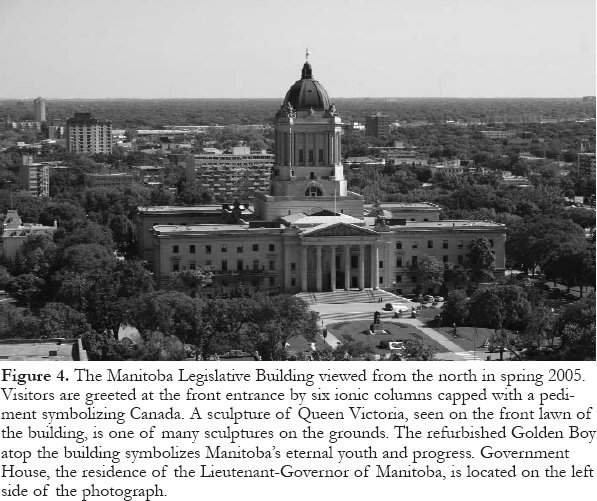
Display large image of Figure 4
Table 1: Lists of costs of the Manitoba Legislative Building.

Display large image of Table 1
Table 2: Descriptions of caissons used in the Manitoba Legislative Building.
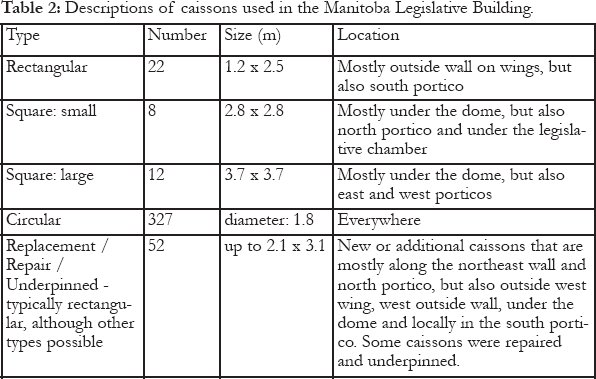
Display large image of Table 2
11 Unconsolidated boulder clay or indurated till typically overlies carbonate bedrock (AM, GR 3085 G8100, Item 6, AM, GR 3085 G8105, Item 121) and is probably equivalent to till described by Baracos and Kingerski (1998). Boulder clay underlies most of the Legislative Building, but is absent in the southwest corner of the building whereas the indurated till occurs under the wings of the building, including the northeast wing, but is typically absent under the dome and central part of the building (AM, GR 3085 G8100, Item 6). Where boulder clay and indurated till occur in the same section, the indurated till underlies the boulder clay. Under the northeast wing of the building where depressions occur in the bedrock surface, several metres of silt occur between the bedrock and indurated till (AM, GR 3085 G8107, Item 549).
12 The boulder clay is overlain by unconsolidated grey clay, generally over-lain by a thinner, yellow clay, which thins to the southwest. The yellow clay also occurs as a discontinuous lens within the grey clay (AM, GR 3085 G8106, Item 176). The grey and yellow clays probably correspond to Agassiz units 1 and 3, respectively (Teller, 1976).
Excavation of Caissons
13 In November 1912, Provincial ArchitectV.W. Horwood suggested a change in foundation design from piles to caissons (Table 2) because of problems with other engineered projects in the Winnipeg area that used piles. The change was implemented in August 1913. Excavation to bedrock of the original 369 caissons (Fig. 5) was started in late August and completed in February 1914 (AM, GR 3085 G8100, Item 6). Under the northeast corner of the building, a caisson intersected up to 3 m of indurated till, but continued excavation never encountered bedrock (AM, GR 3085 G8105, Item 125). To ensure adequate bearing capacity of the indurated till, it was tested once in September 1913 (Fig. 6) and again in October 1913. From this testing, recommendations were adopted that allowed caissons to be taken to indurated till. Recommendations also stated that the indurated till was to be drilled to determine its thickness and the depth to bedrock.
Figure 5. Plan and location of caissons, Manitoba Legislative Building (AM, GR3085 G8107, Item 545). The Legislative Building rests on 421 caissons, 369 of which are original caissons, and 52 of which replaced original caissons of poor quality. Caissons on this figure are to scale. The building is outlined by a thin solid line, except under the stairways at the north and south entrances, where the outline is dashed. The depth to the bedrock surface, measured from the top of the steel grillage that rests on the caissons, has been contoured using a contour interval of 2 m. Depth values under the southern part of the building are between 14 and 15 m; consequently no contours are shown. Beneath the north entrance, contour lines have not been extended under the stairways because the depths to bedrock are poorly constrained.
Display large image of Figure 5
14 Caissons were dug by hand and the spoil removed in buckets to an overhead railway, which took the clay to carts for disposal. Caisson walls were supported during excavation by wood cribbing held in place by iron rings and bolts (Fig.6). Cribbing in one caisson failed, causing deformation of the walls in five adjacent caisson excavations (AM, GR 3085 G8104, Item 53).
15 Seepage into caisson excavations from the underlying carbonate aquifer was a common problem. The potentiometric surface of this aquifer underlying much of Winnipeg is currently above the bedrock surface (Render, 1970), and may have been higher at the time of construction. Evidence suggests that most caissons contained some water, and several contained excessive amounts of water when the concrete pour took place (AM GR1609 G8014 File 5, AM GR1609 G8014 File 3 Item 2).
16 Following the beginning of construction of the first level, cracks appeared in some floors and walls suggesting that some caissons were of poor quality possibly reflecting seepage or that some were installed improperly and had not reached bedrock or induratedtill. (AM, GR 3085 G8102, Item 43). An additional 52 caissons were installed (Fig.5) to replace poor quality caissons, and to repair and underpin caissons that did not reach supporting material (AM, GR 1609 G8014, File 3 Item 1).
Figure 6. Loaded platform for the bearing test on indurated till in the excavation for caisson 39, located adjacent the north portico along the northeast wing (AM, GR3085 G8101, Item 28). The test was done using a progressively loaded platform, 1.68 m square, that was erected on a 3 x 3.6 m rectangular mast extending to indurated till (AM, GR3085 G8100, Item 6). An initial 5 tons of pig iron was placed on the mast and 22 mm of settlement occurred after 3.5 hours. Another 10 tons of pig iron were added at intervals over the next 24 hours. A total of 26 mm of settlement was measured during the 44 hours of the test. Upon removal of the load 6 mm of rebound was measured. Wood cribbing and metal rings support the wall of the caisson excavation.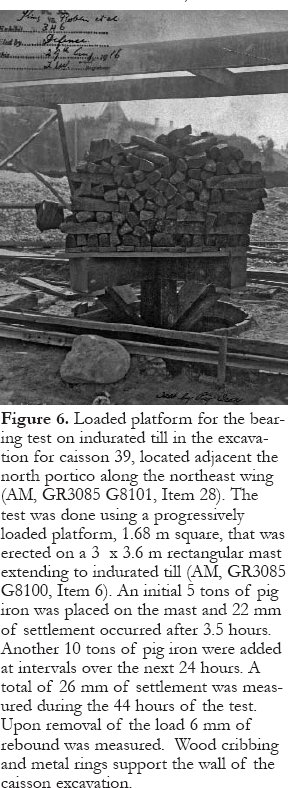
Display large image of Figure 6
Table 3: Dimension stones of the Manitoba Legislative Building.
DIMENSION STONE
17 Dimension stones used in the Legislative Building are from Canada, the United States and Italy (Table 3). The order presented is based on the volume of each stone used in the Legislative Building, from greatest to least. Technical properties of dimension stones are presented in Table 4. Figures 7 through 10 show the different dimension stones in the Legislative Building.
Tyndall Stone
Introduction
18 Tyndall Stone is a grey to buff, mottled, fossiliferous, dolomitic limestone that is quarried at Garson, Manitoba, 37 km northeast of Winnipeg. It belongs to the Late Ordovician (Maysvillian – Richmondian; Elias, 1991) Selkirk Member of the Red River Formation. This stone gives many parts of the Legislative Building its characteristic appearance and is used for exterior walls, columns, bases of pediments, bases of statuary, and the fountain in the south grounds. In the interior it can be seen in walls, columns, the main stairway and gallery balustrades, and some sculptured forms (Figs. 7e, 8a).
19 Tyndall Stone has been quarried in the Garson area since 1895 (Coniglio, 1999). Similar stone was quarried since 1832 near Lower Fort Garry along the Red River. Tyndall Stone has been used extensively in Winnipeg building foundations, but the Legislative Building is probably its first large-scale application as dimension and decorative stone. Since that time it has been considered to be "…one of the best building stones in Canada…" (Parks, 1916, p. 35). The stone on the exterior of the Legislative Building bears this out; in the past 85+ years it has undergone differential weathering so that the mottles and fossils stand out (Fig. 7c), but there has been little cracking or spalling. This is in contrast to the Bedford limestone, which has not withstood the climate so successfully (Fig. 7b). Tyndall Stone, so named because it was shipped from Tyndall near Garson, can be seen in several other important buildings in Canada such as the Parliament Buildings in Ottawa, the Canadian Museum of Civilization in Gatineau, and the Empress Hotel in Victoria.
20 At the time the Legislative Building was being constructed, several companies were operating quarries in the Garson area. The stone came from what was then the Tyndall Quarries, within the large quarry pits toward the northeast corner of the current Gillis Quarries Ltd. site (50° 4.5´ N. Lat., 96°41.8´ W. Long.). The Tyndall Quarries were operated by a syndicate of Winnipeg stone companies, using a range of tools including channellers, horse and steam derricks, jackhammers, and drills (Parks, 1916). A Canadian Pacific Railway spur line ran up to the working face of the quarry, facilitating transport of the quarried blocks. The Tyndall Stone in the Legislative Building was cut and prepared by the Winnipeg Stone Co. plant at 297 Gurney Ave., Winnipeg (Parks, 1916).
21 In the Garson area, stone is quarried from a relatively thin stratigraphic interval, about 6 to 8 m thick (Goudge, 1944; Lee and Elias, 2004). The upper beds tend to be more buff coloured than the grey stone occurring deeper in the quarries. This is considered to be related to weathering by groundwater (Goudge, 1944). The stone is massive, but the thickness of extracted blocks is limited by stylolites.
Table 4: Physical properties of dimension stones of the Manitoba Legislative Building.
Stratigraphy and Sedimentology
22 In the Garson– Selkirk area, the Selkirk Member is about 43 m thick; the Tyndall Stone quarries are within the lower half of the member (Cowan, 1971). The Selkirk Member is underlain by the more purely dolomitic Cat Head Member and overlain by the dolomitic Fort Garry Member (Cowan, 1971).
23 Most Tyndall Stone consists of dolomite-mottled, fossiliferous wackestone, which was deposited in a stable shelf environment. There are scattered bioclastic packstone and grainstone horizons which commonly show fining upward (Wong, 2002); these represent deposition during brief storm events. The packstones and grainstones are generally laterally discontinuous, apparently because of bioturbation between storm events (Westrop and Ludvigsen, 1983). In the Legislative Building, these storm beds and lenses can be seen in the columns inside the front entrance portico, and in columns on the main floor around the Pool of the Black Star. Small chert nodules are rare.
Burrow Mottling and Diagenesis
24 The mottles that give Tyndall Stone its characteristic appearance (Fig.7c) are generally considered to be burrows made by organisms moving through the muds of a soft ancient seafloor (Kendall, 1977). The large burrows that form the mottles are assigned to the ichnogenus Thalassinoides; these were probably produced by arthropods (Kendall, 1977; Coniglio, 1999). Within these large burrows can be seen smaller burrows that have distinct outlines. These were made by organisms, possibly polychaete worms, which mined the original burrow fills for nutrients (Kendall, 1977).
25 The burrows are dolomitized, while the surrounding material is limestone. The surrounding sediment was partly lithified just below the seafloor surface, but burrows remained unlithified because their fill material had different porosity and permeability (Coniglio, 1999). It may have been at this time that the secondary burrowing took place (Coniglio, 1999). The burrow mottles became dolomitized later in the diagenetic process, as magnesium-rich fluids were able to pass through them, but not through the surrounding material (Kendall, 1977; Coniglio, 1999; Gingras et al., 2004). During diagenesis, most mollusc shell material was replaced with dolomicrite (Kendall, 1977).
Macrofossils
26 The most common Tyndall Stone macrofossils are receptaculitids, an extinct group of uncertain affinities, possibly calcareous green algae (Wong, 2002; Figs. 9a, c). The second most abundant group is the solitary rugose corals (horn corals). Other common fossils include stromatoporoid sponges, colonial rugose and tabulate corals, brachiopods, bryozoans, gastropods, cephalopods, and trilobites (Figs. 9b-e). The most abundant bioclasts in Tyndall Stone are sections of echinoderms. These can be readily observed on the outside of the Legislative Building, where grains are more visible as a result of weathering (Fig.7c). Complete echinoderms are very rare because their skeletons were readily broken up after death.
27 Many publications have dealt with various aspects of the Tyndall Stone biotas; perhaps most notable are a few monographs that have placed groups in a modern taxonomic context. These include publications about the rugose corals by Elias (1981), trilobites by Westrop and Ludvigsen (1983), and articulate brachiopods by Jin and Zhan (2001).
28 A detailed paleoecologic study of the Tyndall Stone quarries was carried out by Wong (2002), who noted that fossil abundances vary with height in the quarry, suggesting that subtle environmental changes were taking place. Overall, macrofossils are more abundant in upper beds than in lower ones; relative abundances of receptaculitids and stromatoporoids increase, while those of cephalopods and horn corals decrease. Storm lenses become more common with height. Fossil counts on various parts of the Legislative Building's exterior suggest that stone from different levels in the quarry was selected for the various purposes (Table 5).
29 Unusual fossils occur in a few places in the Legislative Building. Some of the stone in the east portico stair pedestals was quarried from a lens containing a greater density of brachiopods than the authors have seen in more recently quarried Tyndall Stone. The east portico contains two other notable fossils: a superb example of an unusual sponge occurs in one of the stair plinths (Fig. 9d), and the largest fossil measured in the Legislative Building, a stromatoporoid 1.0 m wide and 30 cm high, occurs on one of the pillars. Many other beautiful fossils on both the interior and exterior of the Legislative Building show features such as annual growth banding (Fig. 9e) and overgrowth relationships (Fig. 9c).
Paleogeographic and Paleoenvironmental Setting
30 The Red River Formation was deposited during, and after, a large Late Ordovician marine transgression. Much of North America can be assigned to a single "Red River – Stony Mountain" faunal province that extended from New Mexico to northwest Greenland (Elias, 1981). Tyndall Stone from the Garson area was deposited along the northeastern flank of the Williston Basin (Elias, 1981). The Red River Formation thickens southward and westward, toward the deeper parts of the basin (Andrichuk, 1959). Farther east and north, all Paleozoic sedimentary rocks have been stripped by erosion, exposing the Precambrian basement. As a result, it is not possible to determine the extent of Ordovician deposition, nor whether there was land in this region. The features of Tyndall Stone do not indicate proximity to land.
31 Paleogeographic reconstructions show that this part of North America was slightly south of the equator in the Late Ordovician (Scotese, 2004). The burrow-mottled carbonates and diverse fossil assemblage indicate that deposition took place in a warm inland sea, apparently with normal marine salinity (Westrop and Ludvigsen, 1983; Coniglio, 1999). The periodic storm beds, abundant calcareous algae, and possible algal nature of receptaculitids all indicate deposition in shallow water, below normal wave base but above storm wave base (Westrop and Ludvigsen, 1983; Coniglio, 1999).
Figure 7. (Opposite page) Building stones and their usage in the Manitoba Legislative Building. 7a) Exterior view of east side of the building; walls and plinth are Tyndall Stone, statue is Bedford limestone, and steps are Butler granite. 7b) Bedford limestone of exterior statue showing weathering relief and details of ooid and fossil grains. 7c) Tyndall Stone; detail of exterior stone showing differential weathering between pale buff limestone and darker dolostone burrow mottles; note abundant crinoid grains, particularly in the limestone. 7d) Butler granite, gneissic type. Slab is 1.22 m wide. 7e) Tyndall Stone alcove, second level interior hallway. Tyndall Stone in the walls is oriented parallel to original bedding, except in the keystones of the arch where the stone has been rotated so that bedding is in a radial position; baseboards are of Botticino marble. 7f) Drinking fountain carved from pink-red Tennessee marble shows the characteristic layer-parallel stylolites; the floor is of Tennessee marble and Ordovician black marble, and the baseboard is Botticino marble. 7g) Decorative use of marbles in the rotunda at the top of the Grand Staircase. The carved balustrade encircling the opening to the Pool of the Black Star is Botticino marble; the floor includes grey-pink Tennessee marble, Ordovician black marble, and green Vermont Verde Antique marble. 7h) Marble floor on the main level of the Grand Staircase Hall is composed of pink and grey-pink shades of Tennessee marble, Ordovician black marble, and green Vermont Verde Antique marble.Figure 8. (Opposite page) More building stones and their usage in the Manitoba Legislative Building. 8a) The Grand Staircase Hall; bison pedestals, arches, walls, gallery balustrades and sculptured forms on the ledge above the arches are Tyndall Stone; floors are of three different marbles (see Fig. 7h); steps and carved railings of the Grand Staircase are Botticino marble. Cylindrical columns at the top of the staircase are Tennessee marble. Compare with Figure 3. 8b) Botticino marble; carved railing and steps on the Grand Staircase; 8c) Botticino marble; detail of stone, showing rounded oncolitic structures and dark brown stylolites. 8d) Red marble breccia; detail of stone, showing large clasts containing calcite veins, surrounded by deep red alteration rims and matrix. 8e) Red marble breccia, used as decorative trim on a fireplace in a meeting room. 8f) Ordovician black marble used for the steps and pedestals of the speaker's platform. A strip of light pink Tennessee marble is at the foot of the stairs. 8g) Missisquoi marble floor of an upper level corridor, showing grey-green mottled stromatolitic structures.Tennessee Marble
32 Polished grey, pink, and red Tennessee marbles were used throughout the interior of the Legislative Building for room and hallway flooring (Figs. 7g, h, 8a), for steps, risers and landings within enclosed stairwells, for stately cylindrical columns in the second floor rotunda (Fig. 8a), and for drinking fountains (Fig. 7f) on most levels. This stone was used also in the building's public washrooms for partitions and walls.
33 R. Zurawski, State Geologist and Director of the Tennessee Division of Geology, (pers. comm., 2004), has indicated that this stone came from the Middle Ordovician Holston Formation of the Chickamauga Group. The Holston beds outcrop in the Valley and Ridge fold and thrust belt of eastern Tennessee. The geology of these deposits is described by Gordon (1924).
34 The stone has a fine- to medium-grained, crystalline texture that has been interpreted as diagenetic. The stone qualifies as a marble in the commercial sense only; it is actually a crystalline limestone that takes a good polish. Small crinoid fragments are embedded in many of the crystalline grains and can be seen in the Legislative Building. Otherwise, stone at the Tennessee quarry sites is reported to contain numerous macro-fossils such as bryozoans, brachiopods, pelecypods and gastropods. These larger forms could not be recognized in the Legislative Building stone.
35 The Tennessee marble is characterized by well developed stylolites having two orientations. Those parallel to bedding planes are predominant and those oblique to bedding are less common. The stylolites parallel to bedding are well demonstrated in three dimensions in the corridor drinking fountains (Fig. 7f). Stairwell landings reveal unusual structures related to the intersections of the two orientations of stylolites. The origin of these features appears to have involved irregular dissolution and disturbance of bedding, but otherwise is considered problematic.
36 The variation in colour of the Tennessee stone reflects variations in the amounts of iron oxide. Analyses givenin Gordon (1924), list ferric oxide (Fe2O3) contents in the grey stone as 0.17%; the pink stone as 0.21%; and the deep-red stone as 0.46%.
37 The Holston beds represent Middle Ordovician carbonate deposition on the North American passive margin of the Iapetus Ocean, an ocean ancestral to the Atlantic Ocean. Scotese (2004) indicates that this area was south of the equator at a latitude of approximately 35° during the Middle Ordovician. These beds were only marginally altered by the Taconic orogenic phase of Appalachian tectonic history (Middle Ordovician-Silurian), but underwent thin-skinned folding and thrusting at a later time during the Late Permian Alleghanian Orogeny (Hatcher, 1987).
Figure 9. Examples of the diverse fossils in Tyndall Stone at the Manitoba Legislative building; a to d are on exterior surfaces; e is at the top of the Grand Staircase. 9a) Receptaculitid Fisherites, transverse section; coin diameter is 19 mm. 9b) High-spired gastropod (snail); coin diameter is 19 mm. 9c) Vertical section of receptaculitid (R) encrusted by tabulate coral Protrochiscolithus (P). 9d) Sponge (lower centre), with the chain tabulate coral Manipora (upper left); coin diameter is 26 mm. 9e) Vertical section through colony of the rugose coral Crenulites, showing distinct cyclic banding that probably represents annual growth bands (arrowed).Botticino Marble
38 Cream- to ivory-Botticino marble from Italy was used in the Legislative Building for the steps and carved railings of the impressive Grand Staircase (Figs. 8a, b), for baseboards and benches in the main entry vestibule and other rooms, for the carved balustrade in the centre of the Rotunda (Fig. 7g), for radiator ledges, for baseboards throughout the building (Figs. 7e, f), and for smooth and carved olive-leaf trim around entrances to offices. This stone also serves as lamp footings in the Pool of the Black Star.
39 Botticino marble came from Lombardy Province in northern Italy just north of the Po Basin. The stone (also known formerly as Mazzano marble) was quarried close to the city of Brescia, in the foothills of the Southern Alps. It was quarried from selected carbonate beds within the Lower Jurassic, Sinemurian Stage, Corna Formation (Cassinis, 1968). The Corna beds underwent modest folding and thrusting during the early Miocene and these structures verge toward the south and southeast (Schmid, 2003).
40 The Corna Formation has been described as a fine-grained, compact, allochemical limestone having a veined texture (Italithos, 2004). It has not been metamorphosed and is a marble in the commercial sense only. It contains primary structures described as pseudo-oolites, and also an abundance of fossils including algal masses (oncolites). These features can be observed in the Legislative Building (Fig. 8c). Also reported by Italithos (2004), but more difficult to find in the Legislative Building, are corals, crinoids, sponges, mollusks and forams. Botticino marble has brown stylolites parallel to the bedding (Fig. 8c).
41 The Corna beds represent shallow marine carbonates, deposited on the eastern flank of the Lombardy Basin in northern Italy, as the basin was in the early stages of its development (Winterer and Bosellini, 1981). The Lombardy Basin represented early Jurassic continental extension that signified the oncoming separation and spreading of the Apulian Plate away from the Eurasian plate, leading to the development of the Ligurian Sea. Subsequent closure of the Ligurian Sea in the early Miocene carried these carbonates into contact with the Alpine orogenic front of the Eurasian Plate, resulting in retro-thrusting and folding (Schmid, 2003).
Table 5: Relative abundance (% frequency) of fossils in Tyndall Stone on various exterior surfaces of the Manitoba Legislative Building. Crenulites is a cerioid colonial rugose coral genus, and Protrochiscolithus and Calapoecia are tabulate corals. "Other Fossils" include the colonial rugose coral Palaeophyllum, a non-stromatoporoid sponge, and Tetradium. The portico columns show high frequencies of receptaculitids and stromatoporoids and low frequencies of cephalopods and solitary Rugosa, suggesting that they came from beds near the top of the quarry. Walls above grade have lower frequencies of receptaculitids and stromatoporoids, and higher frequencies of cephalopods and solitary Rugosa, indicating that their stone was derived from beds lower in the quarry. Results for foundation walls and stair plinths are more ambiguous.
Figure 10. Examples of fossils and structures in Ordovician black marble in the Legislative Chamber. 10a) Stromatoporoid sponge, vertical section. 10b) Branching bryozoans associated with echinoderm debris. 10c) Colonial coral Foerstephyllum sp., oblique vertical section. 10d) Vertical section of cross-laminated limestone, with abundant echinoderm (crinoid) debris.Ordovician Black Marble
42 Black marble was used in the Legislative Building for interior decorative purposes. It was used as floor paving bands and diamonds throughout the Legislative Building on the main and second floors (Figs. 7g, h, 8a) and also in the Legislative Chamber at the bases of walls, and as ceremonial pedestals on both sides of the Speaker's platform (Fig. 8f). This stone is a marble in the commercial sense only. Actually, it is a black, fine-grained limestone that takes an excellent polish and contrasts with the white macrofossils that are scattered throughout the stone or concentrated in layers; these are most obvious in the Legislative Chamber, but they can also be seen in the floors.
43 There is uncertainty about the source of this stone. It likely came from Isle La Motte in Lake Champlain, on the Vermont side of the border with New York. In this case the source quarry may have been one of five old quarries on the island that produced a stone called Champlain Black (M.J. Gale, Vermont Geological Survey, pers. comm. 2004). Champlain Black, the North American black marble most widely used in the first part of the twentieth century, was derived from the Crown Point Formation of the Middle Ordovician (Whiterockian) Chazy Group (Norton, 1993). The Crown Point Formation is mostly composed of muddy limestones to calcarenites, with local reefal facies (Oxley and Kay, 1959).
44 In the black marble, the most abundant fossils are crinoid stem segments, but there are also brachiopods, bryozoans, stromatoporoids, cephalopods, gastropods, and corals (Fig. 10a-d). These are similar to forms found in the Crown Point Formation and other Chazyan units. The fossil assemblage includes stromatoporoids similar to the Crown Point Formation's Labechia and Pachystylostroma (Kapp and Stearn, 1975), and examples of the coral genus Foerstephyllum consistent with F. wissleri (Welby, 1961), which occurs in blue-black limestones of the Crown Point Formation in the Lake Champlain area. Nevertheless, we have not been able to identify the most characteristic Crown Point fossil, the gastropod Maclurites magnus (Oxley and Kay, 1959). Consequently the Legislative Building stone could have been derived from some other mid-Ordovician unit, but likely from the New York – Vermont area.
45 The Chazy Group was deposited on a passive North American continental margin as the Iapetus Ocean was undergoing closure. It represents a range of environments from storm-dominated shelf to sand shoals and tidal flats (Mehrtens and Selleck, 2002). The beds were deposited during or shortly after a period of block faulting (Mehrtens and Selleck, 2002), and were deformed into open folds during the Appalachian Taconic Orogeny.
Butler Granite
46 Butler granite is a grey gneissic granite that was used for the steps and landings of the four exterior porticos of the Legislative Building (Figs. 7a, d). The granite came from the Horne Quarry, near Ignace, Ontario, now known as the Butler Quarry that is located in Bradshaw Township, District of Kenora, 7.7 km west of the town of Ignace on the north side of Highway 17, adjacent to the Canadian Pacific Railway right of way.
47 Storey (1986) indicates that the rock is a massive, light grey to white, biotite granite (approximately 5% biotite). A very weak foliation trends north-northwest. There are no obvious knots or inclusions in the granite but there are rare rusty-weathering spots on the weathered surface. The rock polishes well with no plucking of the biotite. The major joint set in the granite strikes Az 110°, with minor sets at 045° and 070°. The stone on the Legislative Building porticos is characterized by local variations in composition and grain size resulting in a layered gneissosity, along with patches of pegmatite.
48 Mineral point count analysis identifies the predominant phase of this rock as a quartz monzonite. The mineralogy is 40% plagioclase (3% of which is myrmekitic), 29% quartz, 28% potassium feldspar (microcline and orthoclase), 3% biotite, with trace magnetite and rare epidote and chlorite.
49 The Butler granite represents part of the Indian Lake batholith (Blackburn et al., 1991), one of many granitoid plutonic complexes that occur within the central Wabigoon Subprovince, of the Superior Province of the Canadian Shield. Two U-Pb zircon crystallization ages for the batholith are both 2671 Ma (Tomlinson et al., 2004). These ages are the youngest within the central Wabigoon Subprovince and suggest that the pluton may be a product of post-collision continental magma generation following earlier Archean continental plate growth as described by Blackburn (1980). The Butler granite represents the oldest dimension stone used in the Legislative Building.
Bedford Limestone
50 Bedford limestone was used for most of the statuary of the Legislative Building (Fig 7a). Decades of weathering have developed some inter-granular relief on the surfaces of the exterior carved works (Fig.7b). The Bedford limestone now is formally known as Salem Limestone, but also simply as Indiana limestone. It was quarried in south-central Indiana, between Bloomington and Bedford. It has been used as a dimension stone for over 100 years because of its uniform texture and ease of working. It is fairly soft and can be shaped easily with carving tools.
51 The limestone is described as a cross bedded calcarenite that is medium-to coarse-grained, tan, grey tan, and light grey, porous, and fairly well sorted. It occurs in exceptionally thick beds. Individual grains are mostly microfossils (including especially the foraminiferid Globoendothyra baileyi), macrofossil fragments, and whole diminutive forms of macrofossils. Coated grains and oolitic textures are also common (Indiana Geological Survey, 1997; Pinsak, 1957).
52 The stone was deposited in an epi-continental, warm-water, marine environment during Mississippian time. The fine-grained oolitic texture suggests that wave action and marine currents winnowed the fossil fragments to a uniform size (Ketter, 2003). The Indiana Geological Survey (1997) classifies this stone as chemically pure, averaging 97 % plus calcium carbonate and 1.2 % calcium-magnesium carbonate.
Vermont Verde Antique Marble
53 Vermont Verde Antique is a serpentine marble that has irregularly mixed green chlorite and intermediate to dark green serpentine, irregularly veined with white calcite. It was used for a variety of decorative purposes in the Legislative Building to provide artistic contrast with the lighter coloured Tennessee and Botticino marbles. (Figs. 7g, h). Examples include the patterned floors of the Grand Staircase hall, the Pool of the Black Star, the Rotunda, and the Manitoba Room on the second floor. Verde Antique was used also as fireplace trim in the Speaker's offices.
54 This marble came from one of several serpentinite bodies near the town of Roxbury, Vermont. M. J. Gale, Geologist, Vermont Geological Survey (pers. comm. 2004) has indicated that several quarries there operated from 1853 through to the 1950s. The serpentinite occurs as pods and lenses in the Missisquoi Formation, a metamorphic complex in Vermont assigned to the Lower Ordovician. Structurally, these rocks occur on the eastern limb of the Green Mountain Anticlinorium.
55 The structural setting, composition, and pod-like form of the source serpentinite bodies have led to the interpretation that the original ultramafic material represents the pre-Taconic oceanic crust (possibly ophiolite) flooring the Iapetus Ocean. The bodies may represent dismembered, complexly sheared and metamorphosed material caught up in an accretionary wedge during the Appalachian Taconic Orogeny (Williams, 1984).
Missisquoi Marble
56 Missisquoi marble (Fig. 8g) was used as flooring in parts of the northern upper-level corridors of the Legislative Building. The stone was described by Parks (1914) as having characteristic colour variations consisting of shades of light and dark grey, sometimes arranged in irregular patterns. The patterns were commonly described as ovoid in form, up to 20 cm across, and locally separated by green stylolites.
57 The Missisquoi marble comes from quarries at Philipsburg, Québec. The stone occurs in beds of the upper member of the Late Cambrian to Early Ordovician Strites Pond Formation (Salad Hersi et al., 2002). Salad Hersi and Lavoie (2001, p.8) indicate that one upper limestone lithofacies of the Strites Pond Formation is composed of crystalline limestone " … characterized by small, irregularly woven, light grey and medium grey patches of dense micrite, which gives a mottled appearance similar to clotted bioherms. Looking from the bedding surface, these bioherms form rounded, ellipsoidal, and irregular mounds with stylolitic boundaries". This description is consistent with the stone in the floors within the alcoves at the two ends of the upper-level north hall, which has the appearance of domical stromatolites that have been cut parallel to bedding (Fig. 8g). Otherwise the Missisquoi marble used on the floors of the upper level is of the non-patterned, light grey type.
58 The attributes of the upper Strites Pond Formation suggest sedimentation in a subtidal to supratidal setting on the North American passive margin during the Late Cambrian to Early Ordovician; the formation was subsequently slightly deformed and metamorphosed to low-greenschist grade during the Taconic Orogeny (Salad Hersi et al., 2002).
Red Marble Breccia
59 This colourful stone was used exclusively as fireplace trim in meeting rooms and in most Ministers' offices (Figs. 8d, e). Records show that the original stone specified for fireplace trim was black marble, and that a later cost-saving substitute was to have been one of several possibilities (AM, GR 1609 G8015, File 4, report on deductions and alterations), none of which was used.
60 Macroscopic examination of this red marble was restricted to properties that could be observed on polished faces around the fireplaces, because it was not possible to extract samples for microscopic or laboratory analysis. The rock is calcareous, and macroscopic structures and textures indicate a history of fragmentation followed by lithification. Most fragments are angular. Larger fragments are grey, buff, or rose and may contain white calcite veins, and commonly have darker red alteration rims. The matrix consists of smaller fragments or fine-grained material having an orange-rose to deep-red colour. No layering or stratification was discerned from the polished surfaces, and no preferred orientation of long dimensions of fragments was identified. The available evidence suggests the possibility of karst dissolution, collapse and brecciation, followed by lithification. As far as can be determined from textural evidence this stone may be a marble in name only.
61 No other relevant archival material has been located concerning the source of this stone. A recent search of commercial stone products has yielded one stone from Picardy Province in France, named Brèche St. Maximin that is similar to the red marble breccia. Notwithstanding, the evidence is not compelling; consequently we use a generic name and acknowledge that the age, geological setting and origin of this stone are uncertain.
OTHER GEOLOGICAL MATERIALS
62 Terrazzo was used primarily for basement floors, reporters' gallery stairs, some corridor floors (within marble borders), and some stairwell landings. The terrazzo material was derived from crushing and sorting waste from the marble and limestone used in the building interior (excluding Tyndall Stone). The specifications for the terrazzo mix were to produce a floor surface showing 85% marble chips and 15% light coloured interstitial cement. The proportions of chips of individual marble types were specified as 10% Verde Antique, 10% dark Tennessee, 80 % combined light coloured marble chips (AM, GR 1609 G8015, File 4, report on marble work and terrazzo).
Construction Aggregate
63 Bird's Hill, 10 km northeast of Winnipeg, was the source of almost all aggregate used in the construction of the Legislative Building (AM, GR 1609 G8016, File 9). The first development of the Bird's Hill gravel and sand deposit took place in the 1890s, and production continues to this day. During construction of the Legislative Building, sand and gravel were transported to the city by train using a special spur line of either the Winnipeg Selkirk & Lake Winnipeg Railway Company, or the Canadian Pacific Railway.
64 The Bird's Hill deposit is an esker-delta complex approximately 15 km in length. It consists of coarse-grained, braided, esker deposits near the western margin, changing to finer deltaic deposits to the east. It is surrounded by silt and clay deposits of glacial Lake Agassiz. Nielsen and Matile (1982) stated that the complex was formed at a retreating ice margin approximately 12,000 years ago. Melt-water carried glacially-derived sediment from two ice margin crevasses into Lake Agassiz and produced the esker-delta complex. Subaqueous mass wasting, wave action from Lake Agassiz, and subaerial erosion modified the original distribution of material.
Brick Clay
65 Approximately ten million bricks were used in the construction of the Legislative Building (Manitoba Royal Commission, 1915). They were used for construction of load bearing walls (piers) on all levels and usually were faced with dimension stone or plaster. Unadorned piers can be observed in service corridors and some storage rooms in the basement, and in service areas above the second floor. Brick piers also were constructed on higher levels to support the dome of the Legislative Building. Two types of brick were used, one buff coloured and the other red. They were manufactured from local materials by two Manitoba brick plants between 1913 and 1916.
66 Most of the bricks are buff coloured and came from the Stephens Brick Company in Portage la Prairie, Manitoba (AM, GR 1609 G8014, File2).The source for the Stephens bricks was postglacial alluvial clay, yellow-grey in colour, that filled abandoned channels of the Assiniboine River near Portage la Prairie, Manitoba. The clay in the channels is 1.5 to 2.7 m thick and is overlain by approximately 0.5 m of soil (Bannatyne, 1970). The Stephens bricks were molded by the soft-mud press process, then dried for eight to ten days, after which they were fired to a buff or pale brown.
67 The red bricks came from a plant operated by the Leary-Alsip Brick Company in Roseisle, Manitoba. Archival material supporting this source was less definite; consequently X-ray analysis was conducted to confirm Leary-Alsip as the manufacturer. Leary-Alsip bricks contain quartz, microcline and muscovite in contrast with the Stephen bricks, which contain diopside and quartz. The source of the Leary-Alsip bricks was the Cretaceous Morden Shale (McNeil and Caldwell, 1981) that is dark and carbonaceous. The Morden Shale was quarried along the Pembina Hills part of the Manitoba Escarpment, from the banks of Roseisle Creek. After crushing and sieving the shale was formed into bricks by a dry press process. The bricks were fired to their typical red colour in a down-draft beehive kiln (Bannatyne, 1970). These bricks were admired by the architect, Frank W. Simon, for their superior strength. (AM, GR 1609 G8014, File 2). The Leary kiln stands today.
68 Chemical analyses and temperature gradient tests relevant to the manufacturing of both types of brick are given by Bannatyne (1970).
ACKNOWLEDGEMENTS
We are grateful to The Honourable R. Lemieux, Manitoba Minister of Transportation and Government Services, for providing access to, and permitting photography within the Legislative Building. We thank the Speaker of the House, the Honourable George Hickes, for special access to the Legislative Chamber. Colette Delaurier, Legislative Building Tour Coordinator, and Todd Miclash, the Legislative Building Manager, were extremely helpful with our research within the building itself. We also extend our gratitude to Chris Kotecki and staff at the Manitoba Archives, O. Botar (Faculty of Architecture, University of Manitoba), Neil Ball (X ray technician, Geological Sciences, University of Manitoba), Ed Dobrzanski (Manitoba Museum), Sandy McCracken (Geological Survey of Canada), Giancarlo Della Ventura and the staff at Italithos, for help in our research, or for supplying information and advice. We also acknowledge considerable input from several staff members of the Manitoba Geological Survey and the Ontario Geological Survey who answered questions and provided useful leads. Erica and Juliana Young provided valuable help as photographic assistants. Brian Bollman (Western Marble & Tile Ltd.), Flavio Patuelli (CIOT Tecnica -Montreal), Barry Bannatyne and Doug Berk helped with our search for the source of the red marble breccia. We thank reviewers A. Baracos, D. Cruden, and D. Van Dine for their insightful comments, which have improved the manuscript. Finally, we wish to thank Dr. Leslie King, Dean of the Clayton H. Riddell Faculty of the Environment, Earth and Resources, University of Manitoba, for her encouragement and help.REFERENCES
Agricola Mineralia, 1987, Manitoba Stone: Energy, Mines and Resources Canada and Manitoba Energy and Mines, Economic and Regional Development Agreement pamphlet,16 p.
Andrichuk, J.M., 1959, Ordovician and Silurian stratigraphy and sedimentation in southern Manitoba, Canada: Bulletin of the American Association of Petroleum Geologists, v. 43, p. 2333-2398.
Anonymous, 1921, Manitoba's imposing parliament buildings: Western Canadian Contractor, June Issue, p. 29-33, continued 56.
Archives of Manitoba (AM), Foote Collection 82, Negative 11780.
Archives of Manitoba (AM), Foote Collection 78, Negative 11781.
Archives of Manitoba (AM), GR 1609 G8014, File 2, Miscellaneous Files, #6 Brick file.
Archives of Manitoba (AM), GR 1609 G8014, File 3, Item 1, Caisson file. Proposed recommendation to council. T. Wallace, December 1915.
Archives of Manitoba (AM), GR 1609 G8014, File 3, Item 2, New Parliament Buildings, Winnipeg.
Archives of Manitoba (AM), GR 1609 G8014, File 5, Letter from F.W. Simon to S.C. Oxton, Deputy Minister of Public Works.
Archives of Manitoba (AM), GR 1609 G8015, File 4, Tenders for completion. Contains reports on (a) marble work and terrazzo paving and (b) on New Parliament Buildings Winnipeg, list of deductions and alterations and summary by F.W. Simon, 1916.
Archives of Manitoba (AM), GR 1609 G8016, File 9, Correspondence of minister 1915-1920, Birds Hill sand and gravel.
Archives of Manitoba (AM), GR 3085 G8100, Item 6, William Salt's log book. December, 1916.
Archives of Manitoba (AM), GR 3085 G8101, Item 28, Test using pig iron. Photograph by L.B. Foote, September 1913.
Archives of Manitoba (AM), GR 3085 G8102, Item 43, Report of inspection and valuation of work executed to date. J.H.G. Russell, August 1915.
Archives of Manitoba (AM), GR 3085 G8104, Item 53, Daily report by site inspector. Elliot, January 1914.
Archives of Manitoba (AM), GR 3085 G8105, Item 121, New Parliament Building Inspection. J.H.G. Russell, July 1915.
Archives of Manitoba (AM), GR 3085 G8105, Item 122, Caisson depths. J.H.G. Russell.
Archives of Manitoba (AM), GR 3085 G8105, Item 125, New Parliament Buildings foundations correspondence. C. Dancer and V. Horwood, September 1913.
Archives of Manitoba (AM), GR 3085 G8106, Item 176, Test holes on site, the new parliament building. F.W. Simon, 1913.
Archives of Manitoba (AM), GR 3085 G8106, Item 196, Plan showing work being done at north portico caissons. July 1916.
Archives of Manitoba (AM), GR3085 G8107, Item 545, Key plan of caissons. F.W. Simon, December 1915, Revised: May 1916.
Archives of Manitoba (AM), GR 3085 G8107, Item 549, Caisson file.
Baker, M., 1986, Symbol in stone: the art and politics of a public building; Manitoba's third Legislative Building: Hyperion Press, 176 p.
Bannatyne, B.B., 1970, The clays and shales of Manitoba: Manitoba Department of Mines and Natural Resources, Publication 67-1, 107 p.
Baracos, A., and Kingerski, D., 1998, Geological and geotechnical engineering for urban development of Winnipeg, Manitoba, in Karrow, P.F. and White, O.L., Urban Geology of Canadian Cities: Geological Association of Canada Special Publication 42, p. 171-190.
Blackburn, C.E., 1980, Towards a mobilist tectonic model for part of the Archean of northwestern Ontario: Geoscience Canada, v. 7, no.2, p. 64-72.
Blackburn, C.E., Johns, G.W., Ayer, J. and Davis, D.W., 1991, Wabigoon Subprovince, in Geology of Ontario, Ontario Geological Survey, Special Volume 4. Part 1, p. 303-382.
Bodnar, D., 1979, The Prairie Legislative Buildings of Canada: M.A. Thesis, University of British Columbia, 213 p.
Cassinis, G., 1968, Stratigrafia e tettonica dei terreni mesozoica compres tra Brescia e Serle: Atti Ist. Geologiche Università di Padova, v. XIX, p. 50-152.
Coniglio, M., 1999, Manitoba's Tyndall Stone; Wat on Earth: Waterloo University Earth Sciences Newsletter, Spring 1999, p. 15-18.
Cowan, J., 1971, Ordovician and Silurian stratigraphy of the Interlake area, Manitoba: Geological Association of Canada, Special Paper 9, p. 235-241.
Elias, R.J., 1981, Solitary rugose corals of the Selkirk Member, Red River Formation (late Middle or Upper Ordovician), southern Manitoba: Geological Survey of Canada, Bulletin 344, 53 p.
Elias, R.J., 1991, Environmental cycles and bioevents in the Upper Ordovician Red River-Stony Mountain solitary rugose coral province of North America: Geological Survey of Canada, Paper 90-9, p. 205-211.
Gingras, M.K., Pemberton, S.G., Muehlenbachs, K., and Machel, H., 2004, Conceptual models for burrow-related, selective dolomitization with textural and isotopic evidence from the Tyndall Stone, Canada: Geobiology, v. 2, p. 21.
Goudge, M.F., 1944, Limestones of Canada, their occurrence and characteristics, part V, western Canada: Canada, Department of Mines and Resources, no. 811, 233 p.
Gordon, C.H., 1924, Occurrence and distribution of marble deposits of East Tennessee: Tennessee Division of Geology, Bulletin 28, 264 p.
Hatcher, R.D. Jr., 1987, Tectonics of the southern and central Appalachian internides: Annual Review Earth and Planetary Science, v. 15, p. 337-362.
Indiana Geological Survey (1997), Salem Limestone: available from <http://igs.indiana.edu/geology/structure/compendium/html/comp3mzo.cfm>
Italithos, 2002, Universita degli Studi ROMA TRE, Dipartimento di Scienze Geologiche, Laboratorio Rocce Ornamentali, Botticino Classico: available from <http://www.italithos.uniroma3.it/index.php?ID=203>
Jin, J. and Zhan, R., 2001, Late Ordovician articulate brachiopods from the Red River and Stony Mountain formations, southern Manitoba: National Research Council Research Press, Ottawa, 117 p., 23 pls.
Kapp, U.S. and Stearn, C.W., 1975, Stromatoporoids of the Chazy Group (Middle Ordovician), Lake Champlain, Vermont and New York: Journal of Paleontology, v. 49, p. 163-186.
Kendall, A. C., 1977, Origin of dolomite mottling in Ordovician limestones from Saskatchewan and Manitoba: Bulletin of Canadian Petroleum Geology, v. 25, p. 480-504.
Ketter, B., 2003, University of Wisconsin at Milwaukee: Salem limestone: available from <http://www.uwm.edu/Dept/Geosciences/Urban_Geology/rockdescription.html#Bedford>
Lee, D.-J. and Elias, R.J., 2004, Paleobiologic features of Trabeculites maculatus (Tabulata, Late Ordovician, southern Manitoba): Journal of Paleontology, v. 78, p. 1056-1071.
Leslie, T. W., 1925, The Legislative Building of Manitoba, the keystone province of the Dominion of Canada, situated in the capital city, Winnipeg: Provincial Government of Manitoba, Public Works Dept., 71 p.
Manitoba Royal Commission, 1915, Report of Royal Commission to Inquire into Certain Matters Relating to the New Parliament Buildings. King's Printer, Winnipeg, Manitoba, 82 p.
McNeil, D.H. and Caldwell, W.G.E., 1981, Cretaceous rocks and their foraminifera in the Manitoba Escarpment: Geological Association of Canada, Special Paper 21, 439 p.
Mehrtens, C. and Selleck, B., 2002, The Middle Ordovician Section at Crown Point Peninsula, New York in 93rd Annual New England Intercollegiate Geological Conference Field Trip, P. Karabinos and J. McLellan, editors. Trip B-5. p. B5-1 – B5-16.
Neilsen, E. and Matile, G., 1982, Till stratigraphy and proglacial lacustrine deposits in the Winnipeg area: Field trip #1 Guidebook, Geological Association of Canada – Mineralogical Association of Canada, Joint Annual Meeting; 22 p.
Norton, P.T., 1993, Fossils of the Maine State Capitol: Maine Naturalist, v. 1, p. 194-203.
Oxley, P. and Kay, M., 1959, Ordovician Chazyan series of Champlain Valley, New York and Vermont, and its reefs: Bulletin of the American Association of Petroleum Geologists, v. 43, p. 817-853.
Parks, W.A., 1914, Report on the Building and Ornamental Stones of Canada: Volume 3, Quebec, Canada Department of Mines, Mines Branch Report 279, 304p.
Parks, W.A., 1916, Report on the Building and Ornamental Stones of Canada: Volume 4, Provinces of Manitoba, Saskatchewan and Alberta, Canada Department of Mines, Mines Branch Report 388, 333 p.
Pinsak, A.P., 1957, Subsurface stratigraphy of the Salem Limestone and associated formations in Indiana: Indiana Geological Survey Bulletin, B-11, 62 p.
Render, F.W., 1970, Geohydrology of the metropolitan Winnipeg area as related to groundwater supply and construction: Canadian Geotechnical Journal. v. 7, p. 243-274.
Salad Hersi, O., and Lavoie, D., 2001, Contributions to the sedimentology of the Strites Pond Formation, Cambro-Ordovician Philipsburg Group, southwestern Quebec: Geological Survey of Canada, Current Research 2001-D11, 14p.
Salad Hersi, O., Lavoie, D., and Nowlan, G.S., 2002, Stratigraphy and sedimentology of the Strites Pond Formation, Philipsburg Group, southern Quebec, and implications for the Cambrian platform in eastern Canada: Bulletin of Canadian Petroleum Geology, v. 50, p. 542-565.
Schmid, S.M., 2003, Tectonic evolution of European Alps and forelands: in van der Pluijm, B.A. and Marshak, S., eds., Earth Structure. W.W. Norton and Company, New York. p. 510-523.
Scotese, C.R., Paleomap Project, 2004; available from <http://www.scotese.com/earth.htm>
Storey, C.C., 1986, Building and ornamental stone inventory in the Districts of Kenora and Rainy River: Ontario Geological Survey Mineral Deposits Circular 27, 150p.
Teller, J.T., 1976, Lake Agassiz deposits in the main offshore basin of southern Manitoba: Canadian Journal of Earth Sciences, v. 13, p. 27-43.
Tennessee Marble Company 2004, Marble Specifications; available from <http://www.tnmarble.com/>
Tomlinson, Kirsty Y., Stott, G.M., Percival, J.A., and Stone, D., 2004, Basement terrane correlations and crustal recycling in the western Superior Province: Nd isotopic character of granitoid and felsic volcanic rocks in the Wabigoon sub-province, N. Ontario, Canada: Precambrian Research, v. 132, p. 245-274.
Welby, C.W., 1961, Occurrence of Foerstephyllum in Chazyan rocks of Vermont: Journal of Paleontology, v. 35,p. 391-394.
Westrop, S.R. and Ludvigsen, R., 1983, Systematics and paleoecology of Upper Ordovician trilobites from the Selkirk Member of the Red River Formation, southern Manitoba: Manitoba Department of Energy and Mines, Geological Report 82-2, 51 p.
Williams, H., 1984, Miogeoclines and suspect terranes of the Caledonian-Appalachian orogen: Tectonic patterns in the North Atlantic region: Canadian Journal of Earth Sciences, v. 21, p 887-901.
Winterer, E.L. and Bosellini, A., 1981, Subsidence and sedimentation on Jurassic passive continental margin, southern Alps, Italy: Bulletin American Association of Petroleum Geologists, v. 65, pt. 1, p. 394-421.
Wong, S., 2002, Paleoenvironmental and paleoecological reconstruction of the Tyndall Stone, Selkirk Member, Red River Formation (Late Ordovician), southern Manitoba: M.Sc. thesis, University of Manitoba, Winnipeg, MB, 343 p
